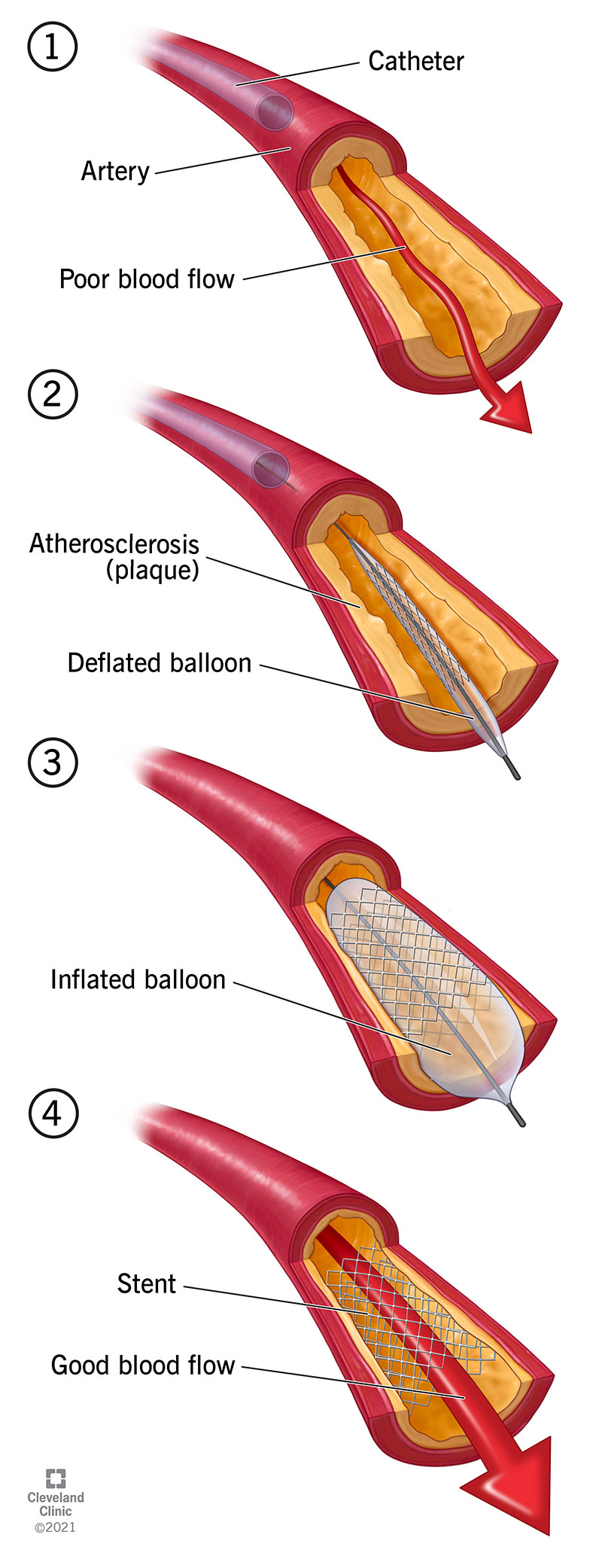Angioplasty is a procedure that creates more space inside an artery that has plaque built up inside it. Your healthcare provider uses a tiny balloon to force plaque against the artery walls so blood can get through your artery. Often, they also place a stent or tube inside the newly opened space to keep it open.
Advertisement
Cleveland Clinic is a non-profit academic medical center. Advertising on our site helps support our mission. We do not endorse non-Cleveland Clinic products or services. Policy
Angioplasty, also called balloon angioplasty, is a procedure that opens arteries to let blood go through more easily. Healthcare providers use this minimally invasive procedure in tight spots in arteries where plaque makes the space inside an artery too narrow or blocks it.
Advertisement
Cleveland Clinic is a non-profit academic medical center. Advertising on our site helps support our mission. We do not endorse non-Cleveland Clinic products or services. Policy
People who have coronary artery disease or a heart attack may need to have coronary angioplasty. Angioplasty is also used in other parts of the body that have narrow or blocked arteries, such as your neck, arms and legs, kidneys and pelvis. Angioplasty allows more blood to get through an artery that’s too narrow or blocked with plaque. This means the organ that artery reaches will get a better supply of blood after angioplasty.
Angioplasty treats atherosclerosis (a collection of plaque made of fat and cholesterol) in your arteries in several different places in your body.
Advertisement
Coronary angioplasty is one of America’s most common procedures.

Your provider will usually ask you to stop drinking or eating for a few hours before your angioplasty procedure. You can plan on your angioplasty procedure taking a half-hour to a few hours, depending on your situation.
At the hospital, you’ll put on a hospital gown. You’ll need to tell your provider what medicines you take and what allergies you have. Your healthcare provider will put an IV in your arm to give you medicine that will relax you. You’ll still be able to respond to your provider’s questions. You’ll also get medicine in your IV that will keep your body from making blood clots.
This description will be about a coronary angioplasty, but providers perform angioplasty in a similar way on other parts of your body. However, they may put the catheter in through a different artery than they would for the heart.
The stent, which your provider expands and locks into position after it’s put in your artery, stays inside your artery long after the angioplasty is done. Many stents have a drug coating that helps prevent your artery from getting too narrow again.
If you have peripheral artery disease, your provider may use a balloon that transfers its medicine coating to the artery wall. The drug stays behind after the balloon is taken out.
You may feel some discomfort when your provider inflates the balloon, but that goes away when they deflate it. Your healthcare provider deflates the balloon after it has done its job. The balloon can be inflated a couple of times in the same spot or in another blocked artery in your body.
Using an angiogram (X-ray images of your blood vessels), your provider can compare how well your blood flowed before and after your angioplasty to see how well it worked.
Your provider will take out the catheters and use a bandage to cover the place where the catheters went into your skin. You may feel someone pressing on the wound to stop the bleeding. You might be sore or have a bruise there later.
Benefits of angioplasty include:
Advertisement
It’s rare to have serious complications after an angioplasty, but every invasive procedure comes with occasional risks. For example, you may need an emergency coronary artery bypass graft during or soon after an angioplasty. Complications happen in around one in 100 procedures, although this might be higher or lower depending on your individual circumstances.
Other angioplasty risks include:
The risk of angioplasty complications is higher for older adults or people who have several blocked arteries, kidney disease or heart failure.
You’ll need to stay at the hospital for several hours or even overnight to recover from angioplasty. Your healthcare provider will tell you what medicines you need and how active you can be after your angioplasty. You’ll need to have someone drive you home from the hospital because you had anesthesia.
Get rest at home and drink fluids. Don’t exert yourself for the next 24 hours. You may need to take medicines like aspirin or other blood thinners after your angioplasty procedure. If your healthcare provider prescribed blood thinners, it’s important to take these as directed. Do not miss any doses. If you think you need to stop taking blood thinners, you should discuss it with your provider before you do.
Advertisement
You should be able to drive and go back to work about a week after your coronary angioplasty. The time may be shorter for other types of angioplasty. Check with your provider.
You’ll have a follow-up visit after you go home, but you should contact your provider if:
You should also tell your provider if you’re having trouble with the anticlotting medicine you take for three to 12 months after receiving a stent.
A note from Cleveland Clinic
Angioplasty can make a difference in how well your blood flows through an artery that had a collection of plaque in it. But even after a successful angioplasty and stent placement, it’s important to live a healthy lifestyle. This includes eating a healthy diet, exercising and not using tobacco products. Be sure to keep taking medicines your provider prescribed and go to all of your follow-up appointments.
Advertisement
Last reviewed on 11/08/2021.
Learn more about the Health Library and our editorial process.